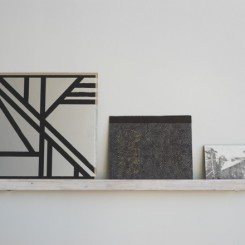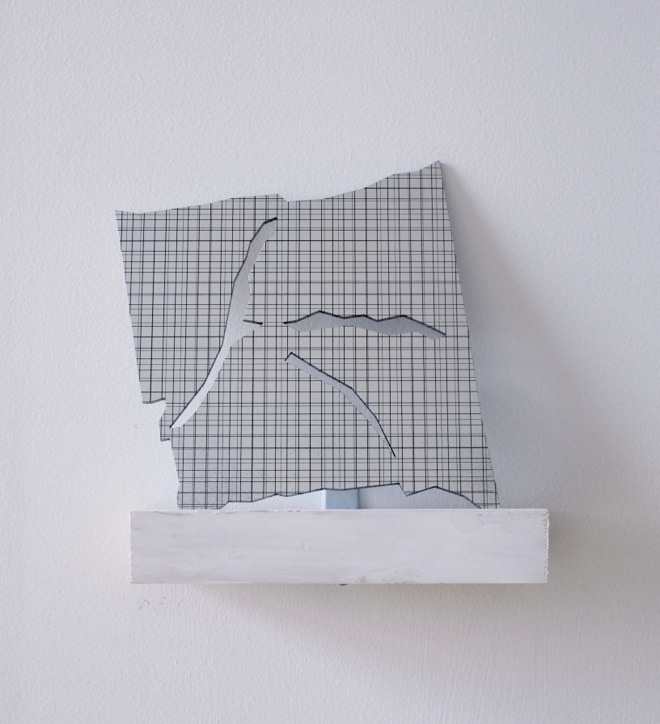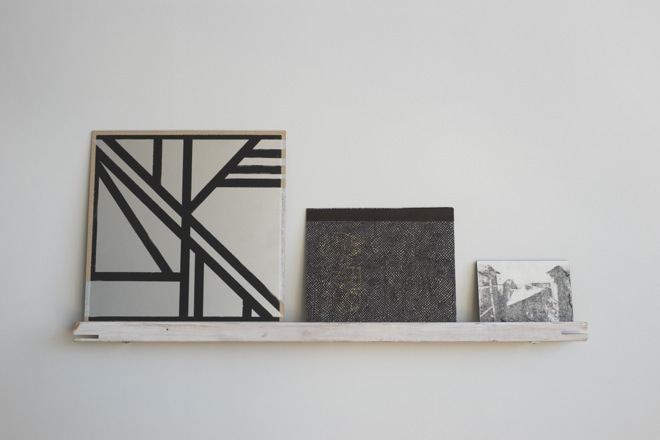Han Bing and Luka Rayski: Frame
Fou Gallery (535 Dean Street, Apartment 507, Brooklyn), March 29–June 8, 2014
A frame is a shape, a drawing. It is both invisible and present—a dotted line that serves to demarcate a designated area or a tangible border which separates inside from out. It is the scintillation of presence, the oscillation between undetectable contours and harsh delineation, where frames force us to have a heightened awareness. For a frame as a mental or visual device not only focuses our attention on what it encompasses, it also forces us to see how this very shape fits within the context from which it is composed.
The journey to Fou Gallery, an exhibition space founded by Echo He and Jessie Yang, is a process of entering and exiting of permeable parameters—like a succession of composed experiences. Entering a gated community, past a doorman, up an elevator and down a hallway lined with a neat queue of drying umbrellas, one finds waiting a grey door to room 507. Yet on the other side of this door is a very atypical commercial exhibition venue. It is Echo and Jessie’s studio apartment in Prospect Heights.
Away from the gallery districts of Chelsea, the Upper East Side and Lower East side, Fou Gallery uses an apartment-exhibition format that has seen a recent rise in popularity, especially in Brooklyn. Due to a mixture of economic, philosophical, aesthetic and purely pragmatic reasons, these home-turned-exhibition-spaces use an alternative framework that grants curatorial flexibility, channeling a DIY mentality while maintaining distinct professionalism. These hybrid spaces reinterpret the perceived dichotomy between the white cube and the undeniable “place-ness” of the exhibition interior. The boundary separating these two entities is slowly deteriorating because the white cube model is no longer a given but a choice. The exhibition space no longer attempts to be invisible or neutral. Instead, it is an opportunity to draw new configurations, to create a frame for how art is shown and a context for how it is seen.
For Fou Gallery’s fourth show, it is only fitting that the exhibition is entitled “Frame.” In their respective methods, Han Bing and Luka Rayski’s paintings explore the motif of the frame as a visual and mental device, reflecting and paralleling the overarching sensibility and experience of Fou Gallery.
Han Bing’s paintings feature scenes that render ambiguous the differences between man-made and natural landscapes, using compositional strategies that reinforce or blur the boundaries between artificial and real space. Clean architectural forms are juxtaposed with semi-transparent nebulous shapes. Areas of accumulated layers press against evaporating washes. In “Landscape #5” (2014), for example, a sliver of paint scaffolds a shape within a ground of dark viridian. An impulsive pallet-knifed pasted yellow and white immediately presses it to the foreground. Suddenly, the shape evokes a billboard, bracketing a new landscape within its confines, distinct from the forest that surrounds it.
This type of framing is often used in Han’s paintings, where realism is both heightened and removed from its context by painterly and sometimes abstract gestures. In “237” (2013), a rectilinear composition emphasizes the different ways in which space is resolved, creating distinct areas of inclusion and exclusion. From a clean grey ground to a gloved figure which holds a photograph of a landscape resembling a moonlit pond, the repeating rectangles simultaneously function as a tangible edge while dissolving to serve as a portal to another vignette.
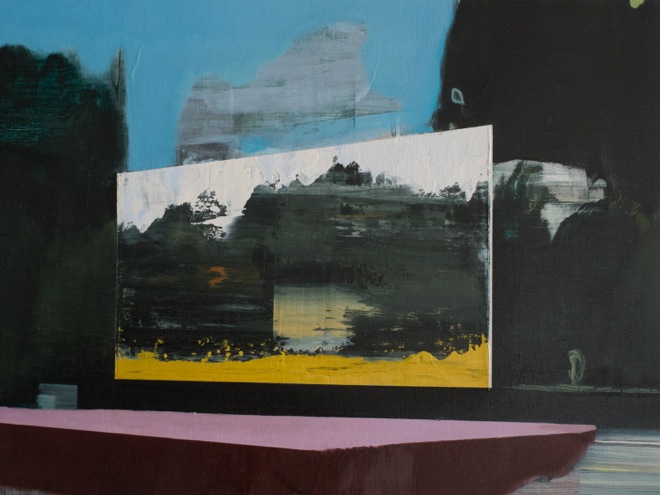
Han Bing, “Landscape #5”, oil on wood board, 12 x 16 in., 2014
韩冰,《风景 5》,木板上油画,30.5 x 40.6 cm,2014
© 2014 韩冰, 致谢否画廊 | © 2014 Han Bing, courtesy Fou Gallery
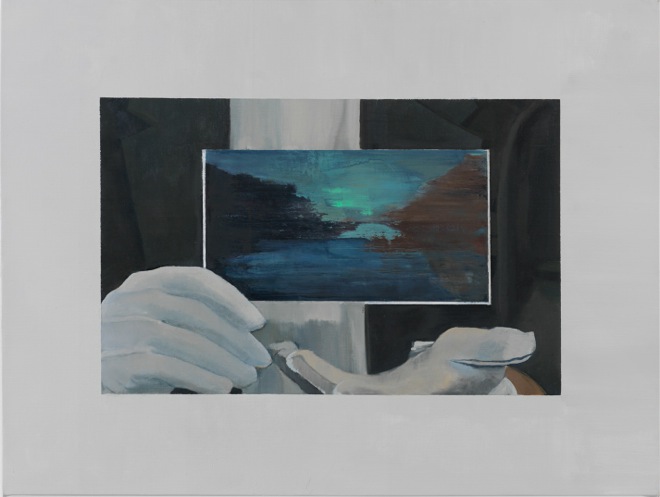
Han Bing, “237”, oil on linen, 18 x 24 in., 2013
韩冰,《237》,亚麻上油画,45.7 x 61 cm,2013
© 2014 韩冰, 致谢否画廊 | © 2014 Han Bing, courtesy Fou Gallery
Luka Rayski’s small clay board paintings at first glance reflect a certain order and consistency, where the visual composition feels compact and concise and the strong forms and prevailing elements rest within a stable framework. However, on closer inspection, intricacies and deviations from this overarching structure expose the “hand” of the painter, allowing the accumulation of gesture to slowly distort and explode the initial grid. In “On My Way”(2014), (a set of five paintings resting on a stretcher bar), parallel etched lines unexpectedly go askew, meanwhile the cross hatching of transparent paint built-up in a variation of ways reveals deformity within the internal logic.
Influenced by photography, Rayski’s process for cultivating and finding an image through a set procedure questions the limitations of sweeping and projected constructs. Rather than using a mechanized methodology, Rayski instead establishes a course of action and underlying logic that he must complete, giving rise to inevitable accidents and failures from the execution. In “America”(2013-14), the grid is reminiscent of a child’s doodle of a spider web, where lines are stretched to reach other points and others are compressed. The end result is almost contradictory of the intended product; a model of efficiency and regularity is reduced to a vibrating and fluctuating network of improvisation and impulse. The scratching, etching, sanding and mark-making in Rayski’s paintings may all embody painting pressing against the confines of the logic of its own making, clearly illustrating the frame of mind and frame of reference in which they were made, and how these borders are in fact always shifting, permeable and, sometimes, even non-existent.
Shows held in alternative spaces are far from novel. From Happenings in the 60s to Hans Ulrich Olbrist’s first show in his kitchen, and gatherings and exhibitions held in Beijing diplomatic enclaves in the late ’80s and early ’90s, there is a distinct history of venues that have sought to reimagine where art belongs and where it should be shown. Yet Fou Gallery extends itself past the alternative gesture into an attempt at a sustainable framework. As a gallery, it is complete with press releases, price lists, visits by appointment and a rigorous accompanying program. Straddling the very border which fluctuates between commercial coldness and an intimate interior for living and staying in, Fou Gallery presents itself as continuously engaged with drawing (and erasing) boundaries that frame these designations.
Just as the whistling of the kettle and the hum of the refrigerator unexpectedly interrupt the viewing of the paintings, the perpetual abrupt realization that Fou Gallery is actually someone’s living space sustains an unexpected awareness. It is between these intervals of awareness that we find ourselves standing at the intersection of the spaces, where different realities press against each other. Aware of the divide and mindful of the differences, one is somehow still able to completely submerge oneself in each.
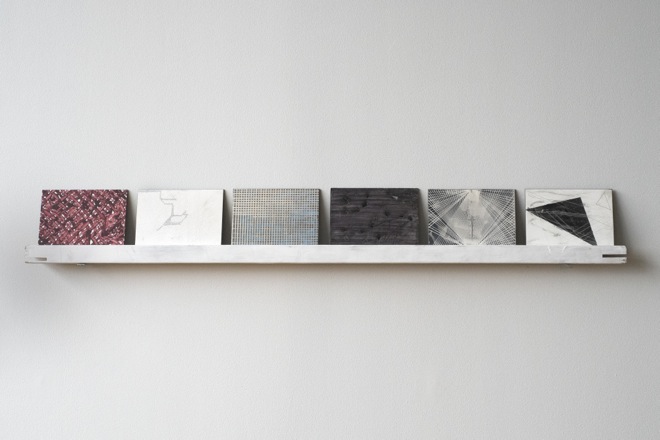
Luka Rayski, “On My Way”, 6 mixed media paintings on claybord, found stretcher bar, 6 x 48 in., 2014
Luka Rayski,《在路上》,高岭土板上综合媒介绘画,拾得画架,15.2 x 71.2 cm,2014
© 2014 Luka Rayski, 致谢否画廊 | © 2014 Luka Rayski, courtesy Fou Gallery

